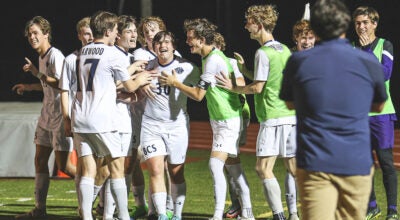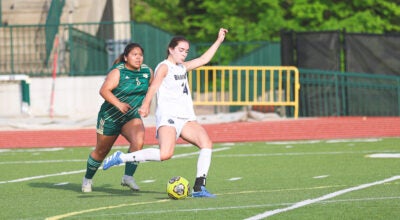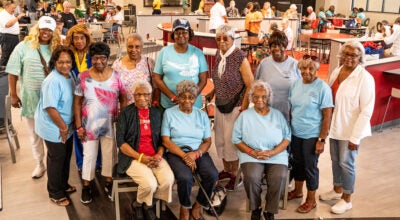Second hearing held for SCS FY 2021 proposed budget
Published 1:35 pm Friday, August 28, 2020
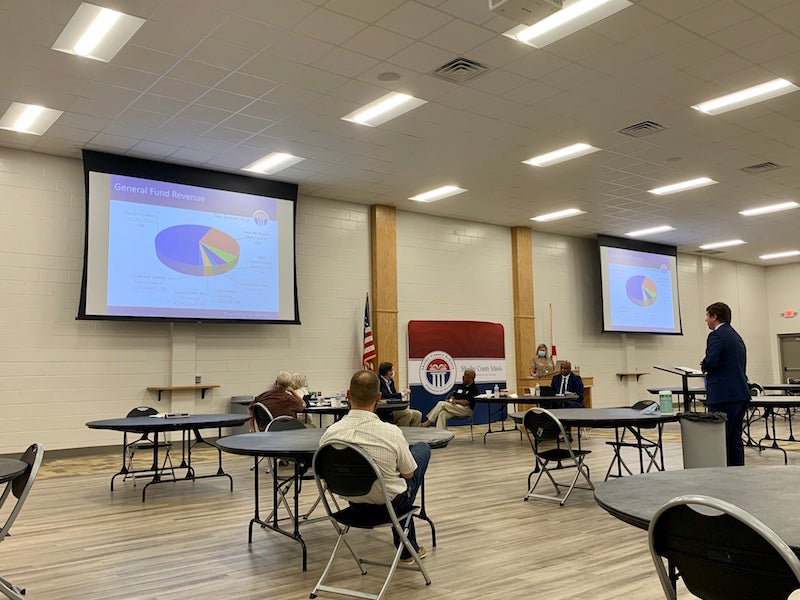
- Shelby County Schools Assistant Superintendent of Finance John Gwin, right, presents information about the school system’s Fiscal Year 2021 proposed budget to the Shelby County Board of Education. (File)
|
Getting your Trinity Audio player ready...
|
ALABASTER – The Shelby County Board of Education received more information about the school system’s proposed budget for the 2021 fiscal year during an Aug. 27 meeting at the Shelby County Instructional Services Center.
Assistant Superintendent of Finance John Gwin presented another group of numbers in the second public hearing held for the proposed budget developed for the fiscal year beginning Oct. 1, 2020 and ending Sept. 30, 2021.
The following is a breakdown of various components of the budget:
Special Revenue Fund Revenue
- Local Schools – $14,111,176.18 (35 percent)
- Special Education – $4,477,119 (11 percent)
- Title Programs – $2,942,385 (7 percent)
- CARES Act – $6,634,538 (16 percent)
- Other $323,125 (1 percent)
- Child Nutrition – $12,255,672 (30 percent)
Total Revenue: $40,744,016
IDEA Expenditures
- Benefits – $900,348 (21 percent)
- Supplies and Equipment – $354,450 (8 percent)
- Services, Dues and Fees – $348,000 (8 percent)
- Substitutes – $319,014 (8 percent)
- Travel – $101,325 (2 percent)
- Supplements – $86,007 (2 percent)
- Indirect Cost – $62,067 (2 percent)
- Salaries – $2,084,578 (49 percent)
Total Expenditures: $4,225,791
Title 1 Expenditures
- Salaries – $1,095,723 (50 percent)
- Benefits – $468,693 (22 percent)
- Supplements – $14,853 (1 percent)
- At-Risk Populations – $16,800 (1 percent)
- Indirect Cost – $31,586 (1 percent)
- Professional Development – $41,700 (2 percent)
- Parent and Family Engagement – $58,257 (3 percent)
- Services and Fees – $75,683 (3 percent)
- Supplies and Equipment – $362,494 (17 percent)
Total Expenditures: $2,165,791
Title II Expenditures
- Salaries – $249,837 (52 percent)
- Benefits – $98,217 (20 percent)
- Professional Development – $107,158 (22 percent)
- Private School Allocation – $18,576 (4 percent)
- Indirect Cost – $7,010 (2 percent)
Total Expenditures: $480,799
CNP Expenditures
- Salaries – $4,379,967 (34 percent)
- Benefits – $2,398,264 (18 percent)
- Food – $4,105,479 (32 percent)
- Indirect Cost – $1,108,583 (9 percent)
- Supplies and Equipment – $420,123 (3 percent)
- Supplements – $215,247 (2 percent)
- Services and Fees – $186,515 (1 percent)
- Substitutes – $168,900 (1 percent)
Total Expenditures: $12,983,081
CNP Revenue
- Transfers-In – $3,176,864 (26 percent)
- USDA Lunch – $3,007,778 (25 percent)
- Paid Meals – $2,649,990 (22 percent)
- A La Carte Sales – $1,607,483 (13 percent)
- USDA Breakfast – $856,020 (7 percent)
- USDA Donated Food – $623,896 (5 percent)
- CNP Rebates – $284,335 (2 percent)
- Other Revenue – $49,302 (0 percent)
Total Revenue: $12,255,672
CARES Act – ESSER
- Building and Disinfecting Services and Supplies – $998,248 (56 percent)
- COVID Related Substitutes – $430,000 (24 percent)
- PPE for Employees – $200,000 (11 percent)
- Private School Allocation – $116,176 (7 percent)
- Bus Disinfecting Services and Supplies – $41,350 (2 percent)
- Instruction Packets – $5,000 (0 percent)
Total Expenditures: $1,790,775
CARES Act – GEER
- Vulnerable Population Resources – $385,000 (31 percent)
- Reading and Home Learning Resources – $337,025 (27 percent)
- After School Tutoring – $192,048 (15 percent)
- Summer School Tutoring – $96,024 (8 percent)
- Private School Allocation – $80,269 (6 percent)
- Dyslexia Dyscalculia Resources – $75,000 (6 percent)
- Professional Development – $50,000 (4 percent)
- Tutoring Supplies – $33,010 (3 percent)
Total Expenditures: $1,248,377
CARES Act – CRF Health and Wellness
- Nurse Salaries – $411,855 (31 percent)
- Benefits – $178,775 (14 percent)
- Nursing Supplies and PPE – $300,000 (23 percent)
- Nursing Equipment – $200,000 (15 percent)
- Temporary Isolation and Barriers – $175,000 (13 percent)
- Contract Nurses – $52,510 (4 percent)
Total Expenditures: $1,318,140
CARES Act – CRF Distance Learning
- Chromebooks and Laptops – $1,599,583 (70 percent)
- Mobile HotSpot Service – $490,000 (22 percent)
- Mobile HotSpots and Wireless Access Points – $93,808 (4 percent)
- Reading Curriculum Training – $64,500 (3 percent)
- Instructional Licenses – $29,353 (1 percent)
Total Expenditures: $2,277,246
Local School Public Funds
- Supplies and Equipment – $5,924,826 (43 percent)
- Services and Fees – $3,490,044 (25 percent)
- Transfers-Out – $2,819,041 (20 percent)
- State Classroom Materials – $834,714 (6 percent)
- State Technology – $485,351 (3 percent)
- State Library – $214,899 (2 percent)
- Debt Service – $43,242 (0 percent)
- State Professional Development – $126,052 (1 percent)
Total Expenditures: $13,938,171
Local School Non-Public Funds
- Fund Raising Supplies – $977,779 (20 percent)
- Instructional Support – $906,146 (19 percent)
- Transfers-Out – $902,991 (19 percent)
- Instruction – $691,664 (15 percent)
- Operations – $203,806 (4 percent)
- Supplies for Donations – $198,369 (4 percent)
- Other – $5,593 (0 percent)
- Extracurricular – $928,229 (19 percent)
Total Expenditures: $4,814,579
System Wide Expenditures
- Instruction – $132,144,411 (48 percent)
- Instructional Support – $40,394,136 (15 percent)
- Operations – $23,422,114 (8 percent)
- Auxiliary – $30,209,757 (11 percent)
- Administrative – $4,995,130 (2 percent)
- Capital Outlay – $21,457,063 (7.75 percent)
- Debt Service – $18,026,495 (6 percent)
- Other – $6,356,973 (2 percent)
Total Expenditures: $277,006,081
The full FY 2021 budget will be brought before the board for approval on Thursday, Sept. 10.
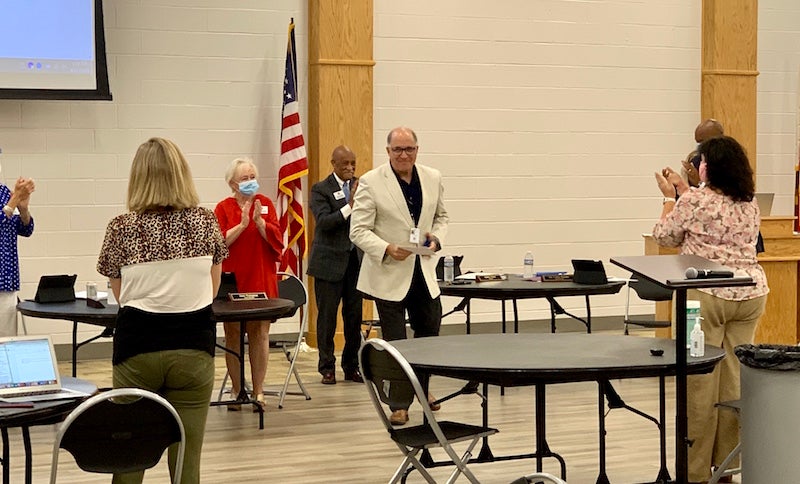
Shelby County Schools Assistant Superintendent of Human Resources Jim Miller is recognized at his last Shelby County Board of Education meeting before his retirement. (Reporter Photo/Emily Sparacino)
In his report, SCS Superintendent Dr. Lewis Brooks recognized Assistant Superintendent of Human Resources Jim Miller, who is retiring.
“I want to thank Mr. Miller for his service to Shelby County Schools,” Brooks said. “We are truly going to miss his expertise and things he has brought to our school system.”
After the meeting, Brooks spoke to and answered questions from local parents in attendance about the school district’s decision to reopen schools earlier this month with a staggered schedule for students, and the outlook beyond the first four-week period amid the ongoing COVID-19 pandemic.
“We recognize there are a lot of questions and concerns about traditional instruction and about remote instruction,” Brooks said. “Our instructional team is working on helping solve some of those issues. I know many of you want kids back in school five days a week, and we want kids back in school five days a week.”
Initially, Shelby County Schools planned to reopen in its green phase of “Back Together,” in which all students who opted for traditional on-campus learning would have started the school year together.
In early August, however, district leaders announced a change in plans from the green phase of the reopening plan to the yellow phase, “Cautious Together,” based on updated guidance from the Alabama Department of Public Health.
In the “Cautious Together” phase, students started the school year on a staggered schedule, with those whose last names begin with letters A-J attending in-person instruction on Monday and Tuesday and eLearning the remaining three days of the week, and students whose last names begin with letters K-Z attending in-person instruction on Thursday and Friday and eLearning the other three days.
In addition, students are required to wear masks on the days they go to their schools for in-person instruction.
“We made a shift prior to starting school going to the cautious phase of our plan because public health was telling us that 6 feet of distance between kids was the standard,” Brooks said. “We felt like we could maintain 3-4 feet to start school with 75 percent of students, but in the 11th hour, we had to make that change because public health said this is the standard you have to go by. I know that causes great anxiety and frustration for parents and working families.”
Brooks said the reopening decisions were made after many discussions among district personnel, school superintendents, Alabama State Department of Education leaders and others in the community regarding the developing situation of COVID-19.
“I don’t make those decisions unilaterally. We are analyzing the data for our school district every day, and we wanted to give ourselves four weeks to look at this,” Brooks said. “We’re at week two, and we feel like we’re in really great shape.”
As of Aug. 27, the percentage of positive cases of COVID-19 for Shelby County Schools was .07 percent, following .05 percent the previous week, Brooks said.
“That means that we’re doing the right things to make sure we mitigate the spread of this disease,” he said. “We are going to be continuing to look at that data every single day. We will make a decision and let everyone know when we will get our kids back in school.”


